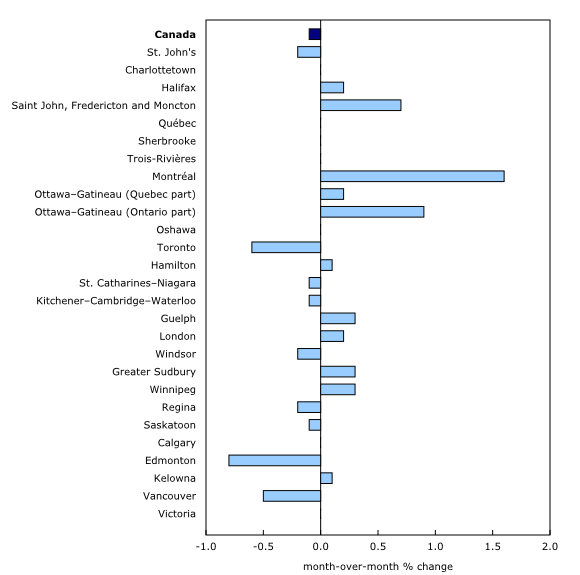New Housing Price Index, July 2019
Archived Content
Information identified as archived is provided for reference, research or recordkeeping purposes. It is not subject to the Government of Canada Web Standards and has not been altered or updated since it was archived. Please "contact us" to request a format other than those available.
Released: 2019-09-12
July 2019
-0.1% 
(monthly change)
July 2019
-0.2% 
(monthly change)
July 2019
0.0%
(monthly change)
July 2019
0.2% 
(monthly change)
July 2019
0.7% 
(monthly change)
July 2019
1.1% 
(monthly change)
July 2019
-0.2% 
(monthly change)
July 2019
0.3% 
(monthly change)
July 2019
-0.1% 
(monthly change)
July 2019
-0.4% 
(monthly change)
July 2019
-0.4% 
(monthly change)
New housing prices were down 0.1% at the national level for the third consecutive month in July.
New Housing Price Index, monthly change
Edmonton (-0.8%) reported the largest price decrease in July, with builders offering promotions and cash rebates to stimulate sales. Canada Mortgage and Housing Corporation reported that single-family home starts in Edmonton were down 25.2% year to date in July compared with the same period in 2018. Single-family homes include single, semi-detached and row houses. Lower demand for housing in this census metropolitan area (CMA) coincided with Edmonton's 7.5% unemployment rate in July, the highest level since October 2017.
Unfavourable market conditions and lower negotiated selling prices led to falling prices in Toronto (-0.6%) and Vancouver (-0.5%) in July. This was the largest decline in Vancouver in nearly a decade.
The prices of new homes continued to increase in Montréal (+1.6%) and Ottawa (+0.9%) in July because of a combination of factors including, higher construction costs and increased demand coupled with low supply in the housing market.
New Housing Price Index, 12-month change
New house prices at the national level were down 0.4% year over year in July, the largest decrease in almost a decade.
Continuing the trend from June, the year-over-year decline in house prices accelerated in Regina (-2.8%), Calgary (-2.6%) and Edmonton (-2.0%) in July. The oversupply of homes, combined with unfavourable market conditions, continued to lower new house prices in these CMAs.
Ottawa (+5.5%) and Montréal (+3.6%) posted the largest year-over-year increases, with favourable market conditions and higher construction costs contributing to the rise.
Note to readers
The New Housing Price Index (NHPI) measures changes over time in the selling prices of new houses agreed upon between the contractor and the buyer at the time of the signing of the contract. It is designed to measure the changes in the selling prices of new houses where detailed specifications pertaining to each house remain the same between two consecutive periods.
The survey covers the following dwelling types: singles, semi-detached and townhouses or row homes. The current value of the structure is independently indexed and is presented as the house series. The survey also collects contractors' estimates of the current value (evaluated at market price) of the land. These estimates are independently indexed to provide the published series for land. The index is available at the Canada and provincial levels, and for 27 census metropolitan areas.
The prices collected from builders and included in the index are market selling prices less value-added taxes, such as the federal goods and services tax or the provincial harmonized sales tax.
The index is not subject to revision and is not seasonally adjusted.
Products
Statistics Canada has a new interactive NHPI dashboard. This web application provides access to new housing price data for Canada and 27 census metropolitan areas (CMAs). The maps, charts and tables draw from information collected from respondents who provide information on Canada's new housing prices. The interactive dashboard allows users to visualize statistics on new housing prices' monthly and annual movements and on rankings by CMA of the largest monthly price movements. This web-based application is updated every month with the release of the NHPI.
The new infographic "What is happening to the prices of new houses in Canada?," which is part of the Statistics Canada — Infographics (11-627-M) series, looks at recent trends in new home prices for select CMAs surveyed.
Statistics Canada has a Housing Market Indicators dashboard. This web application provides access to key housing market indicators for Canada, by province and by CMA. These indicators are automatically updated with new information from monthly releases, giving users access to the latest data.
For more information on the topic of housing, visit the new Housing Statistics Portal.
A video entitled "Producer Price Indexes" is available on the Statistics Canada Training Institute webpage. It provides an introduction to Statistics Canada's producer price indexes—what they are, how they are produced and what they are used for.
Statistics Canada has launched the Producer Prices Portal as part of a suite of portals for prices and price indexes. This webpage provides Canadians with a single point of access to a wide variety of statistics and measures related to producer prices. The portal offers an array of information on topics such as manufacturing, construction, professional services, distributive trades and financial services. The portal will be continually updated as new information becomes available.
Next release
The New Housing Price Index for August will be released on October 10.
Contact information
For more information, or to enquire about the concepts, methods or data quality of this release, contact us (toll-free 1-800-263-1136; 514-283-8300; STATCAN.infostats-infostats.STATCAN@canada.ca) or Media Relations (613-951-4636; STATCAN.mediahotline-ligneinfomedias.STATCAN@canada.ca).
- Date modified:



